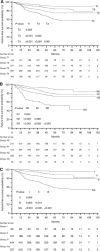Comparison of TNM staging systems for nasopharyngeal carcinoma, and proposal of a new staging system
- PMID: 24149175
- PMCID: PMC3859943
- DOI: 10.1038/bjc.2013.659
Comparison of TNM staging systems for nasopharyngeal carcinoma, and proposal of a new staging system
Abstract
Background: There are few systematic evaluations regarding the sixth and seventh editions of the UICC/AJCC TNM Staging System (TNM6th, TNM7th) and Chinese 2008 Staging System (TNMc2008) for nasopharyngeal carcinoma (NPC).
Methods: We classified 2333 patients into intensity-modulated radiotherapy (IMRT) cohort (n=941) and conventional radiotherapy (CRT) cohort (n=1392). Tumour staging defined by TNM6th, TNM7th and TNMc2008 was compared based on Akaike information criterion (AIC) and Harrell's concordance index (c-index).
Results: For T-classification, TNM6th (AIC=2585.367; c-index=0.6390385) had superior prognostic value to TNM7th (AIC=2593.242; c-index=0.6226889) and TNMc2008 (AIC=2593.998; c-index=0.6237146) in the IMRT cohort, whereas TNMc2008 was superior (AIC=5999.054; c-index=0.623547) in the CRT cohort. For N-classification, TNMc2008 had the highest prognostic value in both cohorts (AIC=2577.726, c-index=0.6297874; AIC=5956.339, c-index=0.6533576). Similar results were obtained when patients were stratified by chemotherapy types, age and gender. Using staging models in the IMRT cohort, we failed to identify better stage migrations than TNM6th T-classification and TNMc2008 N-classification. We therefore proposed to combine these categories; resultantly, stage groups of the proposed staging system showed superior prognostic value over TNM6th, TNM7th and TNMc2008.
Conclusion: TNM6th T-classification and TNMc2008 N-classification have superior prognostic value in the IMRT era. By combining them with slight modifications, TNM criteria can be unified and its prognostic value be improved.
Figures
Similar articles
-
Comparison between the seventh and eighth edition of the AJCC/UICC staging system for nasopharyngeal cancer integrated with pretreatment plasma Epstein-Barr virus DNA level in a non-Chinese population: secondary analysis from a prospective randomized trial.Jpn J Clin Oncol. 2019 Dec 27;49(12):1100-1113. doi: 10.1093/jjco/hyz109. Jpn J Clin Oncol. 2019. PMID: 31334768
-
Validation of the 8th Edition of the UICC/AJCC Staging System for Nasopharyngeal Carcinoma From Endemic Areas in the Intensity-Modulated Radiotherapy Era.J Natl Compr Canc Netw. 2017 Jul;15(7):913-919. doi: 10.6004/jnccn.2017.0121. J Natl Compr Canc Netw. 2017. PMID: 28687579
-
Validation and suggestion of eighth T classifications of the UICC/AJCC staging system for nasopharyngeal carcinoma patients: a retrospective analysis.Jpn J Clin Oncol. 2018 Oct 1;48(10):927-933. doi: 10.1093/jjco/hyy109. Jpn J Clin Oncol. 2018. PMID: 30113640
-
A comparison between the sixth and seventh editions of the UICC/AJCC staging system for nasopharyngeal carcinoma in a Chinese cohort.PLoS One. 2014 Dec 23;9(12):e116261. doi: 10.1371/journal.pone.0116261. eCollection 2014. PLoS One. 2014. PMID: 25536307 Free PMC article.
-
Validation of the 8th edition of AJCC/UICC staging system for nasopharyngeal carcinoma: Results from a non-endemic cohort with 10-year follow-up.Oral Oncol. 2019 Nov;98:141-146. doi: 10.1016/j.oraloncology.2019.09.029. Epub 2019 Oct 4. Oral Oncol. 2019. PMID: 31586896
Cited by
-
M1 stage subdivision and treatment outcome of patients with bone-only metastasis of nasopharyngeal carcinoma.Oncologist. 2015 Mar;20(3):291-8. doi: 10.1634/theoncologist.2014-0206. Epub 2015 Feb 6. Oncologist. 2015. PMID: 25660157 Free PMC article.
-
A Pairwise Meta-Analysis of Induction Chemotherapy in Nasopharyngeal Carcinoma.Oncologist. 2019 Apr;24(4):505-512. doi: 10.1634/theoncologist.2018-0522. Epub 2019 Feb 19. Oncologist. 2019. PMID: 30782977 Free PMC article.
-
Prognostic value of EBV DNA and platelet-to-lymphocyte ratio in patients with non-metastatic nasopharyngeal carcinoma: a retrospective study.BMC Cancer. 2023 Jul 18;23(1):673. doi: 10.1186/s12885-023-11117-5. BMC Cancer. 2023. PMID: 37464319 Free PMC article.
-
Is the gemcitabin-cisplatin combination the optimal induction chemotherapy for non-Asian patients with nasopharyngeal carcinoma (NPC)? Insights from a cohort in northeastern Morocco.Ecancermedicalscience. 2025 Jan 22;19:1829. doi: 10.3332/ecancer.2025.1829. eCollection 2025. Ecancermedicalscience. 2025. PMID: 40177149 Free PMC article. Review.
-
Detection and clinical significance of circulating tumor cells in patients with nasopharyngeal carcinoma.Oncol Lett. 2019 Sep;18(3):2537-2547. doi: 10.3892/ol.2019.10560. Epub 2019 Jul 4. Oncol Lett. 2019. PMID: 31452741 Free PMC article.
References
-
- Akaike H. Information Theory and an Extension of the Maximum Likelihood Principle. Akademia Kiado: Budapest, Hungary; 1973.
-
- Baujat B, Audry H, Bourhis J, Chan AT, Onat H, Chua DT, Kwong DL, Al-Sarraf M, Chi KH, Hareyama M, Leung SF, Thephamongkhol K, Pignon JP. Chemotherapy in locally advanced nasopharyngeal carcinoma: an individual patient data meta-analysis of eight randomized trials and 1753 patients. Int J Radiat Oncol Biol Phys. 2006;64 (1:47–56. - PubMed
-
- CCSNPC Report on revision of the Chinese 1992 staging system for nasopharyngeal carcinoma. J Radiat Oncol. 2013;2 (3:233–240.
-
- Chang ET, Adami HO. The enigmatic epidemiology of nasopharyngeal carcinoma. Cancer Epidemiol Biomarkers Prev. 2006;15 (10:1765–1777. - PubMed
Publication types
MeSH terms
LinkOut - more resources
Full Text Sources
Other Literature Sources
Research Materials


